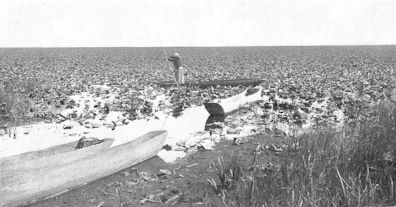Wokas is harvested exclusively in boats of the kind known as a “dugout.” The dugout (wuns) is hollowed from a single log, commonly of the yellow pine (Pinus ponderosa), and ordinarily is about 18 feet long, 2 feet wide, and 16 inches deep (Plate 4). Sometimes logs if Douglas fir (Pseudotsuga mucronata) are used. This tree makes a superior boat, but as the species normally grows at a higher elevation than the lake and marsh, it is less easily available to the boatmaker. the dugout is propelled usually by poling instead of paddling. The role (la-gak’), made of a peeled sapling of the lodge-pole pine (Pinus murrayana), is about 9 feet long and 12 inches thick. The lower end 3 split for a distance of about 6 inches, and the two split points are then spread abruptly to a distance of about 4 inches, where they are held by the insertion of a transverse brace. In all the poles seen the brace consisted of a large wire nail. The triangular base thus formed presents a larger surface to the mud and often permits the pole to rest firmly across one of the stout rootstocks of a wokas plant. Paddles (ka-chik’) are seldom used in wokas harvesting, as the water in the wokas fields is rarely open, and when open is seldom too deep for the propulsion of the boat by poling. Within a wokas field the use of a paddle would be very laborious if not wholly ineffective, while the resistance offered by the plants in the water is readily overcome when the dugout is shoved by a pole resting on the bottom. In localities affording considerable deep open water, paddles also are carried. The other necessary implements in the boat are a flat-bottomed coarse tine basket (tlâks) holding about half a bushel, and a large wicker spoon (näp, or se’-ot a-ko’-olks) made of tule or willow.

When a boat is poled by a single occupant, she takes a position not in the stern, like a paddler, nor at a point a little aft of the middle, like an oarsman, but at a point a few feet from the bow, and for the most effective work she stands instead of kneeling. As the boat is poled slowly along among the wokas plants the woman stoops forward, and, grasping a full-grown wokas pod (ka-kal”-ga’-li), pulls it off its stem and throws it into the boat. At this point occurs the first step of differentiation into grades or qualities of makes. The pod when fully mature bursts open irregularly at the base; the white, moist, but mealy interior, as soon as it is brought into contact with the water begins at once a mucilaginous dissolution, and the seeds are soon scattered in the water. The seeds contained in these dissolving pods are more fully matured, larger, whiter, more palatable, and presumably more nutritious than those of the other pods, and consequently are much more prized and sought after by the Indians. They have a special designation, spokwas (spok’-was), which is applied also to the dissolving capsule itself and to the mucilaginous mass it forms when gathered. Spokwas constitutes only a small part of the whole gathering of wokas, and this fact, in view of the great demand for seeds of this quality, led to the question, Why do not the women gather only the fully matured pods of the spokwas grade? This is clearly answered by the result of a day’s harvest of wokas pods. Ordinarily not more than 10 per cent is spokwas, a proportion due to the rapid dissolution of the fully ripened pods. If the women gathered only these, their day’s harvest would be very small, while by gathering the full-grown but still hard pods they get a several tithes greater product.
The spokwas pods, in a state of mucilaginous dissolution, are lifted from the water not by the hand, but in the wicker spoon already mentioned, and are placed in the tlâks (tlâks), or spokwas basket.
The wokas gatherer’s day is a long and laborious one. The women set out at about 8 o’clock in the morning and, taking a lunch remain on the water until about 6 o’clock in the afternoon. They often go 2 or 3 miles from camp. An hour or so before their arrival the various boats from any one camp may be seen slowly approaching from different directions, the boat itself usually hidden the wokas leaves, its occupant seeming at a distance to glide over the marsh with a spectral motion, unaccompanied by any evident means of support or propulsion. a The alphabet and system of diacritic marks followed in this paper are those of the Bureau of American Ethnology, except that “sh” is here used instead of “c” it the sound of “sh” in shall, and “ch” instead of “te” for the sound of “ch” in church. Secondary accents are not marked when they occur at the normal distance of two syllables from a primary accent.


